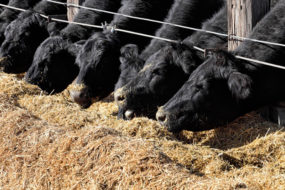With fluctuations in supplemental feed availability and ever-changing feed prices, many of our commonly used byproduct feeds have become harder to source consistently. Byproduct feeds have long been considered as alternatives to grains in the diet. However, with byproduct feed value increasing, in some sense, these “alternatives” are almost the same or higher in price per ton than resources like corn.
I recently participated in a beef cattle management meeting with a producer discussion panel on using varying feedstuffs on the farm. One producer mentioned that his feed broker once told him to “not forget the real thing” when byproduct feed prices or availability fluctuated. While corn prices are also high, we sometimes forget about corn as a tool in our supplementation toolbox.
Beef cow-calf operations can successfully use corn to provide a high-energy feedstuff in the diet. Whole shelled or cracked corn can be used as a supplement for mature cows. Cracked corn has greater digestibility than whole shelled corn, and is an especially good option for inclusion in stocker diets. On average, the National Research Council’s Nutrient Requirements for Beef Cattle states that corn is about 90% total digestible nutrients (TDN) and 8% crude protein (CP).
In most Southeastern cow-calf operations, energy tends to be the first most limiting nutrient in the diet, followed by protein. If additional protein supplementation is needed in the diet, blending corn with cottonseed meal, soybean meal, dried distillers grain or other high-protein (16% CP or greater) supplements will often meet nutritional demands for cow-calf operations.
Start mature cows on 3 to 4 pounds of corn per head per day and increase feed by 1 to 2 pounds every other day until the target level of supplementation is reached. In many cases, mature cows will only need up to 5 to 7 pounds of corn per head per day to meet energy gaps in the diet.
However, it is important to understand the quality provided by the forage base in the operation and adjust feed supplementation levels accordingly.









